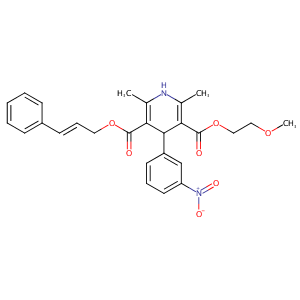Drug Information
| Drug General Information | Top | |||
|---|---|---|---|---|
| Drug ID |
D0N3SR
|
|||
| Former ID |
DCL000288
|
|||
| Drug Name |
Cilnidipine
|
|||
| Synonyms |
Atelec; Cinaldipine; Cinalong; Siscard; Cilnidipine [INN]; FRC 8653; Atelec (TN); FRC-8653; Cilnidipine (JAN/INN); (+-)-(E)-Cinnamyl 2-methoxyethyl 1,4-dihydro-2,6-dimethyl-4-(m-nitrophenyl)-3,5-pyridinedicarboxylate; 1,4-Dihydro-2,6-dimethyl-4-(3-nitrophenyl)-3,5-pyridinedicarboxylic acid 2-methoxyethyl (2E)-3-phenyl-2-propenyl ester; 2-methoxyethyl (2E)-3-phenylprop-2-en-1-yl 2,6-dimethyl-4-(3-nitrophenyl)-1,4-dihydropyridine-3,5-dicarboxylate; 3-O-(2-methoxyethyl) 5-O-[(E)-3-phenylprop-2-enyl] 2,6-dimethyl-4-(3-nitrophenyl)-1,4-dihydropyridine-3,5-dicarboxylate
Click to Show/Hide
|
|||
| Drug Type |
Small molecular drug
|
|||
| Indication | High blood pressure [ICD-11: BA00; ICD-10: I10; ICD-9: 401] | Phase 3 | [1], [2] | |
| Company |
Fuji Viscera Pharmaceutical
|
|||
| Structure |
 |
Download2D MOL |
||
| Formula |
C27H28N2O7
|
|||
| Canonical SMILES |
CC1=C(C(C(=C(N1)C)C(=O)OCC=CC2=CC=CC=C2)C3=CC(=CC=C3)[N+](=O)[O-])C(=O)OCCOC
|
|||
| InChI |
1S/C27H28N2O7/c1-18-23(26(30)35-14-8-11-20-9-5-4-6-10-20)25(21-12-7-13-22(17-21)29(32)33)24(19(2)28-18)27(31)36-16-15-34-3/h4-13,17,25,28H,14-16H2,1-3H3/b11-8+
|
|||
| InChIKey |
KJEBULYHNRNJTE-DHZHZOJOSA-N
|
|||
| CAS Number |
CAS 132203-70-4
|
|||
| PubChem Compound ID | ||||
| PubChem Substance ID |
7848236, 8616904, 12014042, 14786166, 24892414, 26755677, 39315632, 50032253, 50111041, 53790108, 57358530, 75371776, 81092904, 85174238, 85789106, 90341030, 91611858, 92308863, 92712170, 93165423, 99437240, 103587541, 104063686, 113856514, 117867117, 121361210, 124757149, 125163953, 126625786, 126655763, 126656883, 126665639, 131480839, 131840712, 134338944, 135025896, 135692096, 135698202, 135727151, 136367386, 137231387, 137349403, 144205554, 160849806, 162037539, 162177503, 163388008, 163564376, 163621080, 163686403
|
|||
| ChEBI ID |
CHEBI:31399
|
|||
| SuperDrug ATC ID |
C08CA14
|
|||
| Interaction between the Drug and Microbe | Top | |||
|---|---|---|---|---|
| The Abundace of Studied Microbe(s) Regulated by Drug | ||||
| The Order in the Taxonomic Hierarchy of the following Microbe(s): Bacteroidales | ||||
|
Studied Microbe: Bacteroides fragilis enterotoxigenic
Show/Hide Hierarchy
|
[3] | |||
| Hierarchy | ||||
| Abundance Change | Decrease | |||
| Experiment Method | High-throughput screening | |||
| Description | The abundance of Bacteroides fragilis enterotoxigenic was decreased by Cilnidipine (adjusted p-values: 9.53E-03). | |||
|
Studied Microbe: Parabacteroides distasonis
Show/Hide Hierarchy
|
[3] | |||
| Hierarchy | ||||
| Abundance Change | Decrease | |||
| Experiment Method | High-throughput screening | |||
| Description | The abundance of Parabacteroides distasonis was decreased by Cilnidipine (adjusted p-values: 2.70E-03). | |||
|
Studied Microbe: Parabacteroides merdae
Show/Hide Hierarchy
|
[3] | |||
| Hierarchy | ||||
| Abundance Change | Decrease | |||
| Experiment Method | High-throughput screening | |||
| Description | The abundance of Parabacteroides merdae was decreased by Cilnidipine (adjusted p-values: 9.53E-03). | |||
| The Order in the Taxonomic Hierarchy of the following Microbe(s): Eubacteriales | ||||
|
Studied Microbe: Clostridioides difficile
Show/Hide Hierarchy
|
[3] | |||
| Hierarchy | ||||
| Abundance Change | Decrease | |||
| Experiment Method | High-throughput screening | |||
| Description | The abundance of Clostridioides difficile was decreased by Cilnidipine (adjusted p-values: 1.10E-03). | |||
| The Order in the Taxonomic Hierarchy of the following Microbe(s): Lactobacillales | ||||
|
Studied Microbe: Streptococcus parasanguinis
Show/Hide Hierarchy
|
[3] | |||
| Hierarchy | ||||
| Abundance Change | Decrease | |||
| Experiment Method | High-throughput screening | |||
| Description | The abundance of Streptococcus parasanguinis was decreased by Cilnidipine (adjusted p-values: 9.38E-03). | |||
| Target and Pathway | Top | |||
|---|---|---|---|---|
| Target(s) | Voltage-gated calcium channel alpha Cav2.2 (CACNA1B) | Target Info | Blocker | [4], [5] |
| Voltage-gated L-type calcium channel (L-CaC) | Target Info | Blocker | [4], [5] | |
| KEGG Pathway | MAPK signaling pathway | |||
| Calcium signaling pathway | ||||
| Synaptic vesicle cycle | ||||
| Retrograde endocannabinoid signaling | ||||
| Cholinergic synapse | ||||
| Serotonergic synapse | ||||
| GABAergic synapse | ||||
| Dopaminergic synapse | ||||
| Taste transduction | ||||
| Type II diabetes mellitus | ||||
| Morphine addiction | ||||
| Nicotine addiction | ||||
| Panther Pathway | Heterotrimeric G-protein signaling pathway-Gq alpha and Go alpha mediated pathway | |||
| Ionotropic glutamate receptor pathway | ||||
| Metabotropic glutamate receptor group III pathway | ||||
| Metabotropic glutamate receptor group II pathway | ||||
| Thyrotropin-releasing hormone receptor signaling pathway | ||||
| Endogenous cannabinoid signaling | ||||
| GABA-B receptor II signaling | ||||
| Reactome | Depolarization of the Presynaptic Terminal Triggers the Opening of Calcium Channels | |||
| WikiPathways | Calcium Regulation in the Cardiac Cell | |||
| Synaptic Vesicle Pathway | ||||
| References | Top | |||
|---|---|---|---|---|
| REF 1 | URL: http://www.guidetopharmacology.org Nucleic Acids Res. 2015 Oct 12. pii: gkv1037. The IUPHAR/BPS Guide to PHARMACOLOGY in 2016: towards curated quantitative interactions between 1300 protein targets and 6000 ligands. (Ligand id: 7767). | |||
| REF 2 | ClinicalTrials.gov (NCT02145104) Efficacy/Safety of Cilnidipine Plus Valsartan Versus Valsartan in Patients With Hypertension. U.S. National Institutes of Health. | |||
| REF 3 | Extensive impact of non-antibiotic drugs on human gut bacteria. Nature. 2018 Mar 29;555(7698):623-628. | |||
| REF 4 | N- and L-type calcium channel antagonist improves glomerular dynamics, reverses severe nephrosclerosis, and inhibits apoptosis and proliferation in an l-NAME/SHR model. J Hypertens. 2002 May;20(5):993-1000. | |||
| REF 5 | Pharmacology of N-type Ca2+ channels distributed in cardiovascular system (Review). Int J Mol Med. 1999 May;3(5):455-66. | |||
If You Find Any Error in Data or Bug in Web Service, Please Kindly Report It to Dr. Zhou and Dr. Zhang.

